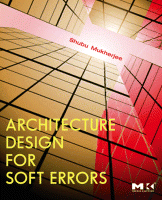Browse content
Table of contents
Actions for selected chapters
- Full text access
- Book chapterNo access
CHAPTER 1 - Introduction
Pages 1-41 - Book chapterNo access
CHAPTER 2 - Device- and Circuit-Level Modeling, Measurement, and Mitigation
Pages 43-78 - Book chapterNo access
CHAPTER 3 - Architectural Vulnerability Analysis
Pages 79-120 - Book chapterNo access
CHAPTER 4 - Advanced Architectural Vulnerability Analysis
Pages 121-160 - Book chapterNo access
CHAPTER 5 - Error Coding Techniques
Pages 161-206 - Book chapterNo access
CHAPTER 6 - Fault Detection via Redundant Execution
Pages 207-251 - Book chapterNo access
CHAPTER 7 - Hardware Error Recovery
Pages 253-295 - Book chapterNo access
CHAPTER 8 - Software Detection and Recovery
Pages 297-325 - Book chapterNo access
Index
Pages 327-337
About the book
Description
Architecture Design for Soft Errors provides a comprehensive description of the architectural techniques to tackle the soft error problem. It covers the new methodologies for quantitative analysis of soft errors as well as novel, cost-effective architectural techniques to mitigate them.
To provide readers with a better grasp of the broader problem definition and solution space, this book also delves into the physics of soft errors and reviews current circuit and software mitigation techniques. There are a number of different ways this book can be read or used in a course: as a complete course on architecture design for soft errors covering the entire book; a short course on architecture design for soft errors; and as a reference book on classical fault-tolerant machines.
This book is recommended for practitioners in semi-conductor industry, researchers and developers in computer architecture, advanced graduate seminar courses on soft errors, and (iv) as a reference book for undergraduate courses in computer architecture.
Architecture Design for Soft Errors provides a comprehensive description of the architectural techniques to tackle the soft error problem. It covers the new methodologies for quantitative analysis of soft errors as well as novel, cost-effective architectural techniques to mitigate them.
To provide readers with a better grasp of the broader problem definition and solution space, this book also delves into the physics of soft errors and reviews current circuit and software mitigation techniques. There are a number of different ways this book can be read or used in a course: as a complete course on architecture design for soft errors covering the entire book; a short course on architecture design for soft errors; and as a reference book on classical fault-tolerant machines.
This book is recommended for practitioners in semi-conductor industry, researchers and developers in computer architecture, advanced graduate seminar courses on soft errors, and (iv) as a reference book for undergraduate courses in computer architecture.
Key Features
- Helps readers build-in fault tolerance to the billions of microchips produced each year, all of which are subject to soft errors
- Shows readers how to quantify their soft error reliability
- Provides state-of-the-art techniques to protect against soft errors
- Helps readers build-in fault tolerance to the billions of microchips produced each year, all of which are subject to soft errors
- Shows readers how to quantify their soft error reliability
- Provides state-of-the-art techniques to protect against soft errors
Details
ISBN
978-0-12-369529-1
Language
English
Published
2008
Copyright
Copyright © 2008 Elsevier Inc. All rights reserved
Imprint
Morgan Kaufmann
